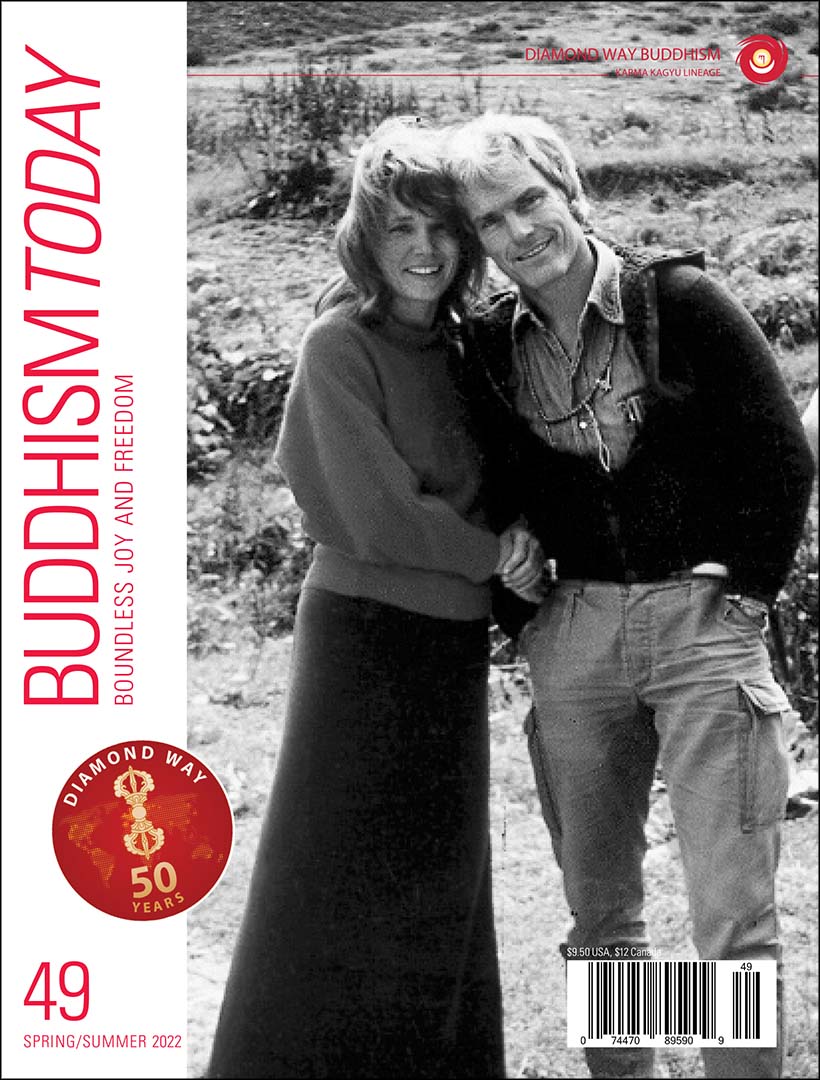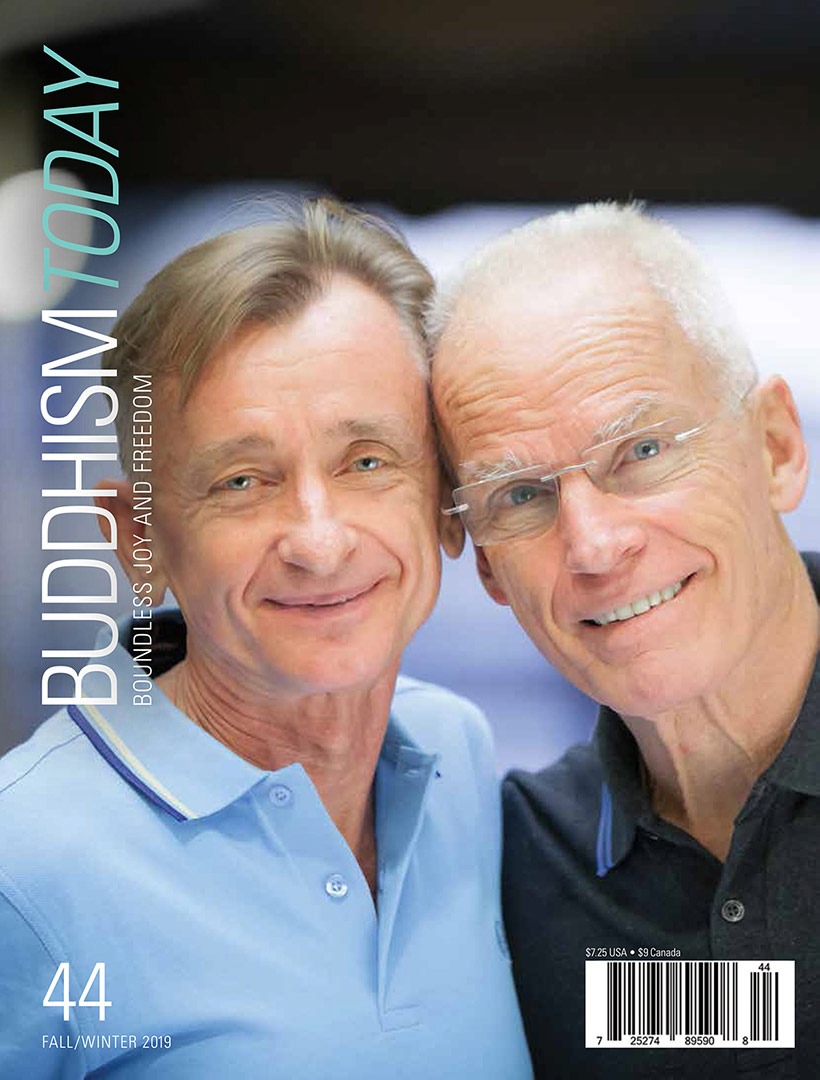The Karmapa on Courage as Compassion
In August 2019, at the Europe Center in Immenstadt, Germany, the sangha welcomed His Holiness the 17th Gyalwa Karmapa Thaye Dorje, his wife Sangyumla, and their son Thugseyla. On the second day of Karmapa’s visit, more than 7,500 students were gathered in the tent at the Europe Center, to receive the empowerment of Loving Eyes (Tib. Chenrezig), the Buddha aspect representing enlightened compassion. Following the empowerment and the blessing, which lasted several hours, Karmapa addressed the crowd, explaining the meaning of the dissolution phase, where the visualized meditation form of Loving Eyes and his pure land are dissolved into emptiness.
Most of us are used to starting something new, doing something different, creating and refreshing things. Those are everyday things, so we are quite used to it.
But to really observe something where things are slowly starting to decay, slowly starting to degenerate— these are words that may sound depressing. Actually, there is nothing really depressing about it; it’s just change, transformation.
If we have learned anything, if we have understood anything from our practice, then this is where our courage comes in: the courage where we are able to face these degenerative aspects, these changing aspects, these transformational aspects…
As long as there is this drive, or this force called compassion, then the courage will automatically come. We use this courage to look at all of the changing aspects: the four aspects of life: birth, aging, falling ill, and dying. We carefully use our courage to see these transformations and then this creates the atmosphere, the opportunity to gain what is known as enlightenment…
The truth is that we don’t have to fear when we let go, when we dissolve every last bit. There is nothing to worry about—the truth is that, given the right conditions, all of it will arise again, the whole pure land, the whole pure manifestation of Chenrezig. All of the Buddha planes or fields will arise as before.
So, there is no such thing as the end or the finale. Maybe that’s a bit abstract. But if I put it in a casual way, then this experience that we call life, however important or unimportant it may be, of course sooner or later it will come to a form of end. When the conditions are there it will arise and re-arise over and over again. That repetition cannot be categorized as good or bad—it just is.
From the samsaric or the conceptual point of view, this same process is seen as something negative. Those who have understood nirvana, those who are awake, look at the same thing and see it as beauty. That’s the difference. It’s just a matter of perspective…
At the end of every session of meditation, once we have dissolved everything and rest in that state of awareness, we see ourselves once again as Chenrezig. It is like the planting of a seed for the benefit of all sentient beings, so that, should there be an activity again, we are always there. So there is no real end, no final end—that’s how it seems to be…
Then we just meditate once again as Chenrezig, in an instant, in a moment, and then we carry on with our everyday rituals, no matter how insignificant we think they are. We go back to eating, walking, sleeping, getting up, and the same process over and over again. It doesn’t matter whether it is mundane or not mundane, as long as we have picked up this courage called compassion. Then everything is pure.
So having said all that, I would like for all of us to dedicate all of this merit to sentient beings.
In conclusion, Karmapa once again expressed his appreciation for Lama Ole and his activity, and gave some essential advice to the students about how to relate to the spiritual teacher:
If we go around looking in all corners of the world, we will not find a teacher like him. It is your merit, therefore cherish it the best way you can. As we know, Buddha has always said that in order to properly cherish the teacher one must not focus on the person but on the person’s practice, on the person’s essence. Therefore, that’s something you really have to focus on, and if you do that, no matter where you turn to, the teacher will always be there. So, I would like to remind all of you of that. And as I said, I’m sure we’ll see each other very soon.
THE END OF THIS LIFE
Thaye Dorje, His Holiness the 17th Gyalwa Karmapa, was asked “I have one month left to live. What should I do?”
He responded:
This setting sun is not the end to all things. We think that it is, but in fact it is not. If we are true students of the Buddha dharma, we know that it keeps going. There may be a gap of some sort, but the cycle just continues.
What can we do to prepare for the end? We may try many things to soothe the inevitable, but in the end all we are doing is attempting to soften it. We can chant some mantras or do some special practice, but it will not change the facts. We need to try and accept this eventuality, and in doing so we can actually form some sort of courage. We need to be brave. With our dignity intact, we can use this time to reflect on the fact that all things change, all things end, and all things will eventually die.
If we can do this, then instead of people consoling us in our last hours and days, we can console them. This understanding can be a pinnacle moment of our lives as dharma practitioners, when we really and truly realize the benefit we can have for others with our bravery. In fact, our experience and understanding will be that much more comforting and real for them because it is true.
We become a powerful experience for others. When they in turn must go through incredible difficulties, our experience will guide them and let them know that it isn’t the end, they aren’t alone, and they have nothing to fear. Then, we don’t run away from fear, or try to soften or cover it up. We have learned to go beyond it.





